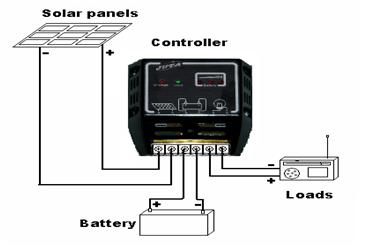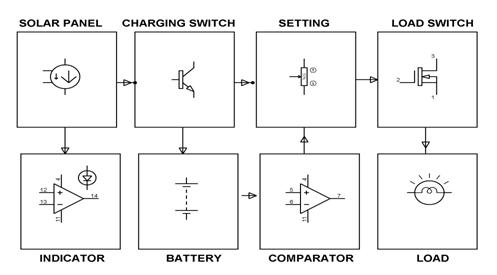Solar Charge Controller Types, Functionality and Applications
A solar charge controller is fundamentally a voltage or current controller to charge the battery and keep electric cells from overcharging. It directs the voltage and current hailing from the solar panels setting off to the electric cell. Generally, 12V boards/panels put out in the ballpark of 16 to 20V, so if there is no regulation the electric cells will damaged from overcharging. Generally, electric storage devices require around 14 to 14.5V to get completely charged. The solar charge controllers are available in all features, costs and sizes. The range of charge controllers are from 4.5A and up to 60 to 80A.
Types of Solar Charger Controller:
There are three different types of solar charge controllers, they are:
- Simple 1 or 2 stage controls
- PWM (pulse width modulated)
- Maximum power point tracking (MPPT)
Simple 1 or 2 Controls: It has shunt transistors to control the voltage in one or two steps. This controller basically just shorts the solar panel when a certain voltage is arrived at. Their main genuine fuel for keeping such a notorious reputation is their unwavering quality – they have so not many segments, there is very little to break.
PWM (Pulse Width Modulated): This is the traditional type charge controller, for instance anthrax, Blue Sky and so on. These are essentially the industry standard now.
Maximum power point tracking (MPPT): The MPPT solar charge controller is the sparkling star of today’s solar systems. These controllers truly identify the best working voltage and amperage of the solar panel exhibit and match that with the electric cell bank. The outcome is extra 10-30% more power out of your sun oriented cluster versus a PWM controller. It is usually worth the speculation for any solar electric systems over 200 watts.
Features of Solar Charge Controller:
- Protects the battery (12V) from over charging
- Reduces system maintenance and increases battery lifetime
- Auto charged indication
- Reliability is high
- 10amp to 40amp of charging current
- Monitors the reverse current flow
Function of Solar Charge Controller:
The most essential charge controller basically controls the device voltage and opens the circuit, halting the charging, when the battery voltage ascents to a certain level. More charge controllers utilized a mechanical relay to open or shut the circuit, halting or beginning power heading off to the electric storage devices.
Generally solar power systems utilize 12V of batteries. Solar panels can convey much more voltage than is obliged to charge the battery. The charge voltage could be kept at a best level while the time needed to completely charge the electric storage devices is lessened. This permits the solar systems to work optimally constantly. By running higher voltage in the wires from the solar panels to the charge controller, power dissipation in the wires is diminished fundamentally.
The solar charge controllers can also control the reverse power flow. The charge controllers can distinguish when no power is originating from the solar panels and open the circuit separating the solar panels from the battery devices and halting the reverse current flow.
Applications:
In recent days, the process of generating electricity from sunlight is having more popularity than other alternative sources and the photovoltaic panels are absolutely pollution free and they don’t require high maintenance. The following are some examples where solar energy is utilizing.
- Street lights use photovoltaic cells to convert sunlight into DC electric charge. This system uses solar charge controller to store DC in the batteries and uses in many areas.
- Home systems use PV module for house-hold applications.
- Hybrid solar system uses for multiple energy sources for providing full time backup supply to other sources.
Example of Solar Charge Controller:
From the below example, in this a solar panel is used to charge a battery. A set of operational amplifiers are used to monitor panel voltage and load current continuously. If the battery is fully charged, an indication will be provided by a green LED. To indicate under charging, over loading, and deep discharge condition a set of LEDs are used. A MOSFET is used as a power semiconductor switch by the solar charge controller to ensure the cut off load in low condition or over loading condition. The solar energy is bypassed using a transistor to a dummy load when the battery gets full charging. This will protect the battery from over charging.
This unit performs 4 major functions:
- Charges the battery.
- Gives an indication when battery is fully charged.
- Monitors the battery voltage and when it is minimum, cuts off the supply to the load switch to remove the load connection.
- In case of overload, the load switch is in off condition ensuring the load is cut off from the battery supply.
Block Diagram of Solar Charge Controller by Edgefx Kits
A solar panel is a collection of solar cells. The solar panel converts the solar energy into electrical energy. The solar panel uses Ohmic material for interconnections as well as the external terminals. So the electrons created in the n-type material passes through the electrode to the wire connected to the battery. Through the battery, the electrons reach the p-type material. Here the electrons combine with the holes. When the solar panel is connected to the battery, it behaves like other battery, and both the systems are in series just like two batteries connected serially. The solar panel has totally consisted of four process steps overload, under charge, low battery and deep discharge condition. The out from the solar panel is connected to the switch and from there the output is fed to the battery. And setting from there it goes to the load switch and finally at the output load. This system consists of 4 different parts-over voltage indication and detection, over charge detection, over charge indication, low battery indication and detection. Incase of the over charge, the power from the solar panel is bypassed through a diode to the MOSFET switch. Incase of low charge, the supply to MOSFET switch is cut off to make it in off condition and thus switch off the power supply to the load.
Solar energy is the cleanest and most available renewable energy source. The Modern technology can harness this energy for a variety of uses, including producing electricity, providing light and heating water for domestic, commercial or industrial application.
Photo Credit:
- Solar Charge Controller by moxiedevices
http://www.elprocus.com/solar-charge-controller/



ليست هناك تعليقات:
إرسال تعليق